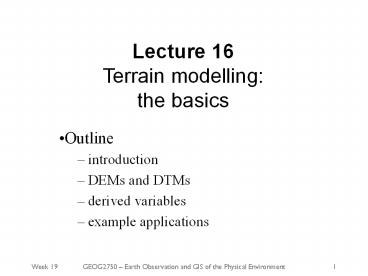Lecture 16 Terrain modelling: the basics - PowerPoint PPT Presentation
Title:
Lecture 16 Terrain modelling: the basics
Description:
surface drapes (point, line and area data) Animated fly-through' What if? modelling ... Draped image. Week 19. GEOG2750 Earth Observation and GIS of the ... – PowerPoint PPT presentation
Number of Views:241
Avg rating:3.0/5.0
Title: Lecture 16 Terrain modelling: the basics
1
Lecture 16Terrain modellingthe basics
- Outline
- introduction
- DEMs and DTMs
- derived variables
- example applications
2
Adding the third dimension
- In high relief areas variables such as altitude,
aspect and slope strongly influence both human
and physical environments - a 3D data model is therefore essential
- use a Digital Terrain Model (DTM)
- derive information on
- height (altitude), aspect and slope (gradient)
- watersheds (catchments)
- solar radiation and hill shading
- cut and fill calculations
- etc.
3
DEMs and DTMs
- Some definitions
- DEM (Digital Elevation Model)
- set of regularly or irregularly spaced height
values - no other information
- DTM (Digital Terrain Model)
- set of regularly or irregularly spaced height
values - but, with other information about terrain surface
- ridge lines, spot heights, troughs, coast/shore
lines, drainage lines, faults, peaks, pits,
passes, etc.
4
UK DEM data sources
- Ordnance Survey
- Landform Panorama
- source scale 150,000
- resolution 50m
- vertical accuracy 3m
- Landform Profile
- source scale 110,000
- resolution 10m
- vertical accuracy 0.3m
5
Comparison
Landform Panorama
Landform Profile
6
LIDAR data (LIght Detection And Ranging)
Horizontal resolution 2m Vertical accuracy 2cm
7
Modelling building and topological structures
- Two main approaches
- Digital Elevation Models (DEMs) based on data
sampled on a regular grid (lattice) - Triangular Irregular Networks (TINs) based on
irregular sampled data and Delaunay triangulation
8
DEMs and TINs
DEM with sample points
TIN based on same sample points
9
Advantages/disadvantages
- DEMs
- accept data direct from digital altitude matrices
- must be resampled if irregular data used
- may miss complex topographic features
- may include redundant data in low relief areas
- less complex and CPU intensive
- TINs
- accept randomly sampled data without resampling
- accept linear features such as contours and
breaklines (ridges and troughs) - accept point features (spot heights and peaks)
- vary density of sample points according to
terrain complexity
10
Task
- Make you own TIN from a piece of paper
11
Derived variables
- Primary use of DTMs is calculation of three main
terrain variables - height
- altitude above datum
- aspect
- direction area of terrain is facing
- slope
- gradient or angle of terrain
12
Question
- What might slope and aspect maps be used for?
13
Calculating slope
- Inclination of the land surface measured in
degrees or percent - 3 x 3 cell filter
- find best fit tilted plane that minimises squared
difference in height for each cell - determine slope of centre (target) cell
z a bx cy
14
Calculating aspect
- Direction the land surface is facing measured in
degrees or nominal classes (N, S, E, W, NE, SE,
NW, SW, etc.) - use 3 x 3 filter and best fit tilted plane
- determine aspect for target cell
15
Other derived variables
- Many other variables describing terrain
features/characteristics - hillshading
- profile and plan curvature
- feature extraction
- etc.
16
Examples
height
slope
aspect
hillshading
plan curvature
Feature extraction
17
Question
- What other important variables can be derived
from DEMs?
18
Problems with DEMs
- Issues worth considering when creating/using DTMs
- quality of data used to generate DEM
- interpolation technique
- give rise to errors in surface such as
- sloping lakes and rivers flowing uphill
- local minima
- stepped appearance
- etc.
19
Example applications
- Visualisation
- terrain and other 3D surfaces
- Visibility analysis
- intervisibility matrices and viewsheds
- Hydrological modelling
- catchment modelling and flow models
- Engineering
- cut fill, profiles, etc.
20
Terrain visualisation
- Analytical hillshading
- Orthographic views
- any azimuth, altitude, view distance/point
- surface drapes (point, line and area data)
- Animated fly-through
- What if? modelling
- photorealism
- photomontage
- CAD
21
Examples of hillshading and orthographic
projection
Hillshading
Orthographic projection
DEM
22
Example surface drape
Rainfall
Draped image
DEM
23
Example animated fly-through
24
Photorealism
25
Photo-realism what if? visualisation
Visualisation 1 before felling
Visualisation 3 strip felling
Visualisation 2 clear-cut
26
Wind farm photomontage
before
after
wire-frame model
27
Conclusions
- Need for third dimensional GIS
- especially in environmental applications
- new data models/structures
- new opportunities for analysis
- Basic uses and derived variables
- Application areas
- visualisation
- visibility analysis
- etc.
28
Practical
- Using DEMs for hillslope geomorphology
- Task Derive key variables from DEM and relate to
slope profiles - Data The following datasets are provided for the
Hohe Tauern Alps, Austria - 25m resolution DEM
- 10m interval contour data (derived from 25m
resolution DEM)
29
Practical
- Steps
- Display DEM in ArcMap or GRID
- Derive slope and aspect variables using slope and
aspect functions in GRID - Derive valley cross and long profiles using the
identity tool in ArcMap - Plot altitude, slope and aspect against distance
along profile in Excel - Relate to physical form
30
Learning outcomes
- Familiarity with TIN/DEM construction in Arc/Info
- Experience with deriving surface variables
- Experience with displaying surfaces in Arcplot
31
Useful web links
- View global DEMs
- http//www.ngdc.noaa.gov/mgg/image/images.htmlrel
ief - DEM derived operations
- http//www.powerdata.com.au/derive.htm
32
After reading week
- Terrain modelling applications
- Access modelling
- Landscape evaluation
- Hazard mapping
- Practical Visibility assessment































